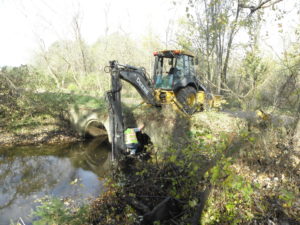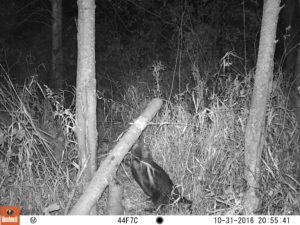By Glen Wunderlich
Before getting into this week’s topic, a brief update is in order on the beavers’ dam building reported last week. As you may recall, some beavers along the Osburn drain in Shiawassee County had constructed a dam in the culverts under our public road, threatening a flood. The DNR issued a nuisance permit to me, and accordingly, a friend set two traps, as the only legal means of control.
A county employee returned my telephone call on Monday after the Friday message and, as promised, sent a backhoe and operator to clear the dam.

Shiawassee County on the job
A valiant effort cleared one culvert but was unable to get the adjacent side open. The following day, a county pickup truck and workers finished the job manually.
Since then, a beaver has been spotted on camera
and the dam is being rebuilt. Plans are to reset the traps when the trapping season begins November 10th and the nuisance permit expires.
Eager and relentless beaver killing poplar trees
Photo Taking Tips
With firearms deer season a bit over a week away, there will be plenty of picture taking in the works. How you prepare could make the difference between a tasteful remembrance and a tasteless afterthought. Here are some ideas to put your trophy in the best light for the years to come.
It’s always best to get photos of any animal and hunter before field dressing. Sometimes we don’t think about it, but once that knife does its work, it limits what can be tastefully captured. Understand that a picture of an open chest cavity may be fine for your hunting pals, but it has no redeeming value to anyone. Blood in the picture is to be avoided, as much as possible.
A field-dressing kit can be kept at the ready replete with paper towels, water, disposable rubber gloves, knives, etc – and, of course a camera. A quick wipe down before field dressing that eliminates or minimizes blood or wounds is necessary. Put the tongue back in the deer’s mouth and try to focus on the head of the animal, along with that of the hunter. And, while you’re at it, get that baseball cap’s visor tipped back before snapping the shot. Look for anything in the scene that detracts from the subjects.
And, that brings me to why we want to capture the moment afield: because the back of a pickup truck or hanging on a rope doesn’t measure up to quality. Clean up your background or move to a better location.
The digital age allows us take as many photos as we wish. A good trick used by pros is to use the “burst” mode on your camera. Yes, it will take several pictures that appear to be the same. However, merely pushing the button can cause movement in the camera and thus can mean blurred results in the first photo in the string, or the only photo without burst mode.
Keeping your light source behind you and onto the subject is a good place to start. Watch for casting your own shadow over scene. Change perspectives and be sure to get some shots from low angles.
If you’d like to include your firearm in the photo, make sure the action is open and that the muzzle is pointed in a safe direction.
Get close. Filling the frame in your viewfinder with only your subject matter is always better than using the zoom feature. In most instances, people don’t really want or need to see the entire body of the deer in the photo. Concentrate photo composition on the hunter’s face and the head of the deer. Even in daylight, using a flash can provide better pictures, so try it with and without the flash.
With a little forethought, a good photo can be enjoyed long after the venison vanishes.









